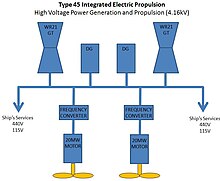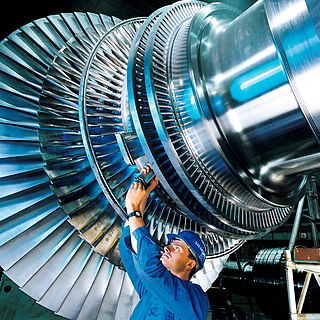
A steam turbine is a machine that extracts thermal energy from pressurized steam and uses it to do mechanical work on a rotating output shaft. Its modern manifestation was invented by Charles Parsons in 1884. Fabrication of a modern steam turbine involves advanced metalwork to form high-grade steel alloys into precision parts using technologies that first became available in the 20th century; continued advances in durability and efficiency of steam turbines remains central to the energy economics of the 21st century.
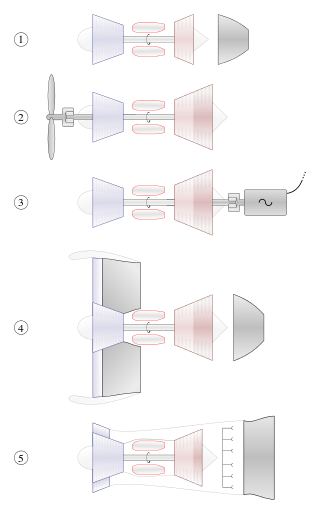
A gas turbine, gas turbine engine, or also known by its old name internal combustion turbine, is a type of continuous flow internal combustion engine. The main parts common to all gas turbine engines form the power-producing part and are, in the direction of flow:

An icebreaker is a special-purpose ship or boat designed to move and navigate through ice-covered waters, and provide safe waterways for other boats and ships. Although the term usually refers to ice-breaking ships, it may also refer to smaller vessels, such as the icebreaking boats that were once used on the canals of the United Kingdom.

A diesel–electric transmission, or diesel–electric powertrain, is a transmission system for vehicles powered by diesel engines in road, rail, and marine transport. Diesel–electric transmission is based on petrol–electric transmission, a transmission system used for petrol engines.

Combined diesel and gas (CODAG) is a type of propulsion system for ships that need a maximum speed that is considerably faster than their cruise speed, particularly warships like modern frigates or corvettes.

The General Electric LM2500 is an industrial and marine gas turbine produced by GE Aviation. The LM2500 is a derivative of the General Electric CF6 aircraft engine.

USS Makin Island (LHD-8), a Wasp-class amphibious assault ship, is the second ship of the United States Navy to be named for Makin Island, target of the Marine Raiders' Makin Island raid early on in the United States' involvement in World War II.

A stealth ship is a ship that employs stealth technology construction techniques in an effort to make it harder to detect by one or more of radar, visual, sonar, and infrared methods.
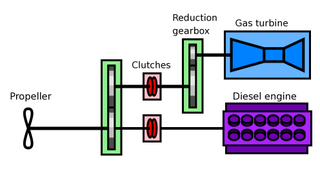
Combined diesel or gas (CODOG) is a type of propulsion system for ships that need a maximum speed that is considerably faster than their cruise speed, particularly warships like modern frigates or corvettes.
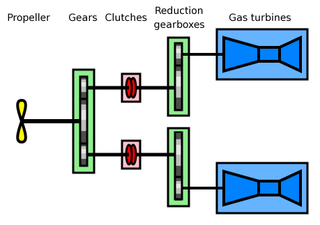
Combined gas turbine and gas turbine (COGAG) is a type of propulsion system for ships using two gas turbines connected to a single propeller shaft. A gearbox and clutches allow either of the turbines to drive the shaft or both of them combined. Marine usage of COGAG systems are similar to those found ashore.
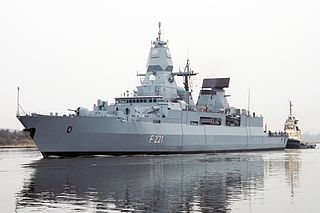
The F124 Sachsen class is the German Navy's latest class of air-defense frigates. The design of the hull is based on that of the F123 Brandenburg class but with enhanced stealth features designed to deceive an opponent's radar and acoustic sensors. The class incorporates an advanced multifunction radar APAR and a SMART-L long-range radar which is purported to be capable of detecting stealth aircraft and stealth missiles.
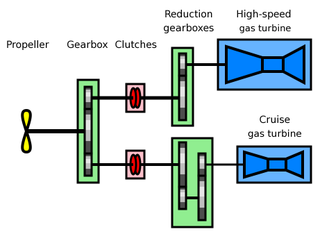
Combined gas or gas (COGOG) is a propulsion system for ships using gas turbine engines.
MILGEM project (Turkish:Milli Gemi Projesi, English: National Ship Project) is a national warship program of the Republic of Turkey. Managed by the Turkish Navy, the project aims at developing multipurpose corvettes, frigates and destroyers that can be deployed in a range of missions, including reconnaissance, surveillance, early warning, anti-submarine warfare, surface-to-surface and surface-to-air warfare, and amphibious operations.

Marine propulsion is the mechanism or system used to generate thrust to move a watercraft through water. While paddles and sails are still used on some smaller boats, most modern ships are propelled by mechanical systems consisting of an electric motor or internal combustion engine driving a propeller, or less frequently, in pump-jets, an impeller. Marine engineering is the discipline concerned with the engineering design process of marine propulsion systems.
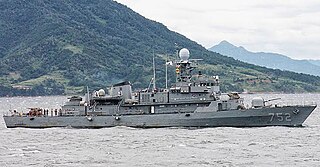
The Donghae-class PCC is the low-end complement of the high-low mix domestic naval construction plan of the Republic of Korea Navy under the 1st Yulgok Project (1974-1986) for the Republic of Korea Armed Forces. The ship is designed for patrolling maritime border, including the Northern Limit Line, protecting the littoral zone, and combating the North Korean vessels.

Integrated electric propulsion (IEP), full electric propulsion (FEP) or integrated full electric propulsion (IFEP) is an arrangement of marine propulsion systems such that gas turbines or diesel generators or both generate three-phase electricity which is then used to power electric motors turning either propellers or waterjet impellors. It is a modification of the combined diesel-electric and gas propulsion system for ships which eliminates the need for clutches and reduces or eliminates the need for gearboxes by using electrical transmission rather than mechanical transmission of energy, so it is a series hybrid electric propulsion, instead of parallel.

The Rolls-Royce Marine Olympus is a marine gas turbine based on the Rolls-Royce Olympus aircraft turbojet engine.

A turbine–electric transmission system includes a turboshaft gas turbine connected to an electrical generator, creating electricity that powers electric traction motors. No clutch is required.
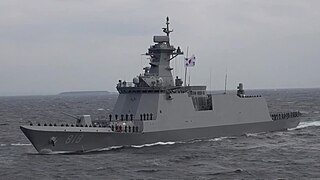
The Daegu-class frigate is a class of guided missile frigates of the Republic of Korea Navy (ROKN). The Daegu class is based on the preceding Incheon class, and has otherwise been referred to as the Incheon class batch II, or FFG-II. Eight Daegu-class ships have been commissioned, with the final goal of 20–22 frigates, of all types, in the ROKN. The Daegu-class frigates were built by Daewoo Shipbuilding & Marine Engineering (DSME) and Hyundai Heavy Industries.

